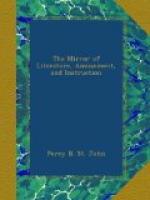It would be unreasonable to expect analyses of Novel stories in a periodical sheet like our Miscellany. We rarely attempt the task of giving them; but prefer giving occasionally a running notice of a meritorious work of this class, and then leave the reader to indulge his taste at the nearest library, upon the strength of our recommendation. To let him into the plot or thread of the story would be ill-judged: for one of the greatest delights of reading, of all ages, is to expect, hope, and despair, by turns, and thus become identified with the feelings and actions of all parties concerned in the narrative. Every lover of novel, tale, and romance must recollect the pleasure of reading Mr. Grattan’s Highways and Byways, and how beautifully the scenes and incidents were grouped in those little series of tales by the roadside. The charming interest of one of them is worth a whole volume of lumbering history of a revolution or royal line. Mr. Grattan, too, has taken all the Low Countries to himself, and the literature of their life belongs to him. The other day he published a history of the Netherlands (noticed in the last volume of the Mirror, page 257); and here we have him again, with The Heiress of Bruges, a tale of the year 1600.
The main story needs not be told; but a scene may be easily detached, to show what spirit-stirring scenes may be expected throughout the work. It needs only be premised that Beatrice, in our extract, is the co-heroine of the Heiress of Bruges, and is sacrificed by the Inquisition in Brussels:—
A law of the Emperor Charles V., passed half a century before, had decreed the frightful punishment of living burial against female heretics, and many executions of the kind had varied by their bloodless atrocity the horrid butcheries committed all through the Low Countries during the tyranny of Alva. After that period such sacrifices had been less frequent; but as late as three years before the date of our story, an instance of this barbarity had publicly taken place in Brussels, by the orders of Albert, who at that time held the highest dignity of the Christian priesthood, next to that of its supreme head. A poor servant girl, named Anne Vanderhove, arrested on a charge of heresy, refused, in all the pride of martyrdom, to renounce her faith. She was condemned to the grave—not to the common occupancy of that cold refuge of the lifeless body, but to all the horrors of living contact and hopeless struggles with the suffocating clay. She suffered her punishment, in the midst of a crowd of curious fanatics; but such was the disgust inspired by the spectacle, that it was thought impolitic to hazard in the face of day another exhibition of the kind. Beatrice’s judges, therefore, after a summary hearing, decreed that she too should be buried alive—but at night. She heard her sentence, in just sufficient exercise of reason to comprehend and shudder at it. But her mind, wandering and unsettled, had not force enough to dwell on the contemplation of what awaited her, and unconscious of her approaching fate gave her the semblance of indifference.




